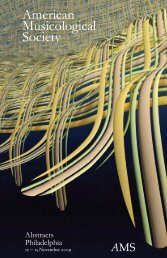Abstracts - American Musicological Society
Abstracts - American Musicological Society
Abstracts - American Musicological Society
You also want an ePaper? Increase the reach of your titles
YUMPU automatically turns print PDFs into web optimized ePapers that Google loves.
6 Thursday Morning: Session 1- 5<br />
AMS/SEM/SMT New Orleans 2012<br />
unique ways the voice is used for gender construction in these genres. More specifically, this is an analysis of sound aesthetics<br />
and other performative aspects demonstrating the sound and image of an ideal woman in East Asia. For example, in Peking<br />
Opera, there are distinct role types for and/or portraying women, each of which represents a specific ideal female; the costumes,<br />
movements and vocalizations are all stylized so as to depict a particular category of woman. Likewise, the male actors<br />
performing women’s roles in kabuki do not merely attempt to “act like a woman” but rather create and construct an “ideal<br />
female likeness” (Mezur 2005) both visually and aurally. P’ansori also provides an interesting case to investigate verbal expressions<br />
of gender ideals as both men and women play all characters in any given story, creating a transgendered space, with little<br />
or no change in physicality, timbre or pitch to distinguish between male and female characters. By comparing and contrasting<br />
these East Asian arts, we can better understand why the ideals developed as they did, why they have continued through<br />
time despite remarkable changes in the “real” world in terms of women and their ideal roles, and how the vocalizations reflect<br />
significant information of the nations of origin.<br />
Yoko Ono and the Gendered Global Voice<br />
Kara Attrep (Bowling Green State University)<br />
Trained in both Western classical music and in Japanese instruments and vocal styles, Yoko Ono’s musical education was<br />
eclectic and diverse. From her avant-garde work with Fluxus in New York in the early 1960s up until the present, Ono has<br />
pushed the boundaries of vocal technique incorporating sounds from all around the globe and influencing younger female<br />
vocalists in a multitude of genres. This paper examines the misunderstandings surrounding some of her early pieces and the<br />
gendered and racial manner in which these pieces are understood and interpreted. Often, Ono’s performing voice is conflated<br />
with her own being—she is her voice. This characterization has led critics, especially in the days right after her marriage to<br />
John Lennon, to define Ono as strange, “other” worldly and even “evil.” It is this conflation of the body with the voice that<br />
has led many to either revere or disparage Ono’s vocal performances. I seek to reconcile the seemingly contradictory readings/<br />
hearings of Ono’s body and voice. Several scholars have examined the gendered and racial aspects of Ono’s performances.<br />
However, I seek to expand these studies and explore the mapping of gendered and racialized identities onto Yoko Ono’s voice<br />
and, by extension, body. By tracing these mappings, I show the complex interconnection between identity, the voice, and the<br />
body through Ono’s performances. Additionally, I examine how Ono’s voice becomes a model for critiquing and labeling<br />
contemporary female artists from around the globe, whose voices and lives are often judged in relation to Ono’s.<br />
A Queer Organology of the Harp<br />
Henry Spiller (University of California, Davis)<br />
Long hours practicing and performing behind a concert pedal harp have convinced me that it is perhaps the West’s queerest<br />
musical instrument. In this paper, I examine some of the harp’s history and characteristics in light of critical theories of sexual<br />
identities and desire (e.g. Foucault, Lacan, Sedgwick, and Butler) to explore the question: how does a musical instrument<br />
become correlated with sexual identities? I argue that players and listeners find it viable to map non-hegemonic desires and<br />
sexual identities to the many ambiguities that surround the harp: its equivocal phallic imagery (does it represent the player’s<br />
own phallus, or does it penetrate his spread legs?); the deceptive enharmonic pedalings that allow the essentially diatonic harp<br />
to “pass” as a chromatic instrument and the closeting of the ungraceful mechanism that enables this chicanery; the feminine<br />
associations that both enabled female harpists to break the gender barrier of professional orchestras and contributed to the<br />
harp’s marginal placement and role in the orchestra; and the commonly-held and frequently-denied assumption, at least in the<br />
late twentieth century, that any male harpist is gay. In line with Foucault’s argument that pre-modern sensibilities regarded<br />
homosexual behaviors as discrete acts rather than components of stable identities, I propose that the harp’s history of ambiguity<br />
has long lent itself to enacting a variety of alternative desires and identities, including assertive women, gentle men,<br />
womanizers, and even asexuality, but which many in the twentieth century, in keeping with modern sexual politics, conflated<br />
into a monolithic homosexual identity.<br />
A Journey of Identity: Jennifer Leitham’s Challenge to Normative Gender Hierarchies of Jazz<br />
Randy Drake (University of California, Santa Barbara)<br />
Jennifer Leitham, a transgender bassist, complicates easy theories about the performance of gender, music, identity, and<br />
subjectivity in jazz. Leitham established her career for many years as a male performer in jazz, but in 2001, she could no longer<br />
tolerate her male identity and changed her sex. The movement of her identity from a perceived normative gender identity of<br />
male, through transgender, to a perceived normative gender of female, represents a deep challenge to the normative subject<br />
position of jazz. Jazz music has been slow to disengage representations of identity related to its historical development among<br />
heterosexual African <strong>American</strong> males. Yet in contrast to this normative position, there are other musicians who address jazz










